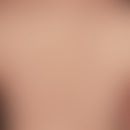Synonym(s)
DefinitionThis section has been translated automatically.
Agents or processes for the cosmetic treatment of the skin, intended to lighten the skin and/or body hair and/or to remove pigmentary irregularities of the skin.
Undesirable pigmentation and hyperpigmentation of the skin (frequent pigmentation disorders occur in women, especially during and after pregnancy, as dark discoloration of the face: melasma). They can be treated medically and cosmetically (not all products allowed for medical use are approved for cosmetics, e.g. hydroquinone).
Physical procedures such as various laser procedures, microdermabrasion and cryotherapeutic procedures are used to lighten the skin. Furthermore, chemical therapy methods are used such as keratolytic, oxidizing and reducing agents (bleaching agents) as well as agents which intervene in the biosynthesis of melanin formation (e.g. tyrosinase-inhibiting preparations).
PreparationsThis section has been translated automatically.
Physical procedures
- Laser and IPL treatments (ruby laser, alexandrite laser, Nd:YAG laser, erbium YAG laser): High-energy light is used in laser treatments. This destroys pigment cells and pigment-bearing keratinocytes in the epidermis. Depending on the type of laser, dermal melanocytes can also be destroyed. The "Q-switched" lasers with extremely short pulses in the nanosecond range can destroy melanin. These laser systems include the 694-nm ruby laser, the 755-nm alexandrite laser, the 532-nm Nd:YAG laser and the 1,064-nm Nd:YAG laser. Superficial ablation leading to pigment removal (resurfacing) is possible with 2940 nm erbium YAG and 10,600 nm CO2 las ers.
- Cryopeeling: Ablative superficial cryotherapy is an elegant method in the hands of experienced therapists to remove hyperpigmentation of the skin. Generally, a single freezing cycle is sufficient to achieve a sufficient effect.
Chemical procedures
Fruit acid peeling: AHA acids (alpha hydroxy acid) such as glycolic acid remove superficial cell material containing melanin. Furthermore, the stimulation of cell proliferation leads to a faster replacement of melanin-containing cells.
Other acid peels: Salicylic acid and highly concentrated free vitamin C (ascorbic acid) also have a keratolytic effect and therefore lighten the skin.
Chemical processes: Melanophobic active ingredients
- Liposomal vitamin C: Liposomal vitamin C (ascorbyl phosphate) inhibits tyrosinase and at the same time the subsequent steps of melanogenesis associated with oxidation. Free vitamin C is less suitable due to its instability to atmospheric oxygen and its low penetration capacity.
- Antioxidants: The antioxidant effect of polyphenols is limited. This applies in particular to polyphenolic compounds such as catechins, resorcins, flavones, isoflavones and gallates or extracts from green and black tea, coffee, soy etc.
Tyrosinase inhibitors
- Rucinol: Rucinol (4-butyl-benzene-1,3-diol) is a tyrosinase inhibitor of the resorcinol type. Rucinol is used in both topical pharmaceutical and cosmetic preparations.
- Butylresorcinol: B-resorcinol belongs to the tyrosinase inhibitors and is used in cosmetic preparations. Skin irritation is rare and B-resorcinol is effective against the most common forms of hyperpigmentation such as melasma and age spots.
- Azelaic acid: Azelaic acid, a competitive inhibitor of tyrosinase, is a naturally occurring, non-toxic dicarboxylic acid. Topical azelaic acid is only effective in high doses, which is only possible in pharmaceutical preparations. In cosmetic, liposomal application form, however, 1% azalea preparations applied over a longer period of time show a lightening effect. Azelaic acid has an antimicrobial effect on acne and rosacea.
- Arbutin in skin lightening herbal extracts: Herbal extracts are often used for the preventive application of skin lightening cosmetic active agents. Their mode of action is not always known in detail. They often contain the hydroquinone derivative arbutin as an active ingredient. Examples include the following plant extracts:
- Mallow (Malva sylvestris)
- Peppermint (Mentha piperita)
- Cowslip (Primula veris)
- Lady's mantle (Alchemilla vulgaris)
- Speedwell (Veronica officinalis)
- Lemon balm (Melissa officinalis)
- Yarrow (Achillea millefolium)
Glutathione (γ-glutamyl-cysteinylglycine) with the molecular formula: C10H17N3O6S, is a small, low-molecular, water-soluble thiol tripeptide. It has an antioxidant effect and indirectly inhibits tyrosinase activity (Sonthalia S et al. 2016). Glutathione inhibits tyrosinase activityin several ways (Yamamura T et al. 2002). Due to its biochemical properties, the potential of glutathione in the treatment of melasma and hyperpigmentation seems plausible (Seçkin HY et al. 2014; Villarama CD et al. 2005).
Ganoderma lucidum polysaccharide (GLP), a natural antioxidant extracted from the fungus Ganoderma lucidum (shiny lacquer mushroom), which occurs in our latitudes. Oral GLP inhibits melanogenesis by blocking UVB-activated protein kinase A (PKA) and the mitogen-activated protein kinase (MAPK) signaling pathway. GLP also protects mitochondria from UVB damage and inhibits the production of reactive oxygen species (ROS) (Hu S et al. 2019).
Lilium lancifolium/tigrinum Root Extract: L-phenylalanine and various phenolic acid derivatives such as regaloside B, regaloside C and regaloside E, as well as polysaccharides have been detected in the root extracts of lilies. The substances exert an inhibitory effect on melanin production by suppressing cAMP-mediated melanogenesis (Park S et al. 2023).
- Arbutin (hydroquinone-beta-D-glucoside): Most skin-whitening plant extracts contain arbutin, a naturally occurring glycosidic hydroquinone compound. Arbutin is mainly obtained from Uvae uris folium, the leaves of the bearberry. Compared to hydroquinone, arbutin has the advantage that it reacts less sensitively to atmospheric oxygen. Only a small proportion of arbutin is broken down into its individual components(hydroquinone). Nevertheless, the release of hydroquinone is classified by the BfR as a cause for concern.
- Hydroquinone(not permitted in cosmetics in Europe): Hydroquinone is not permitted in cosmetic whiteners. Hydroquinone is only allowed in hair dyes (max. 0.3%) with the warning "contains hydroquinone". Hydroquinone is freely available in the USA in cosmetics at concentrations < 2%.
- Hydroquinone(allowed in medical preparations): Hydroquinone (2%-4%) is used in medical preparations for hyperpigmentation. The substance inhibits tyrosinase. Accordingly, a preventive effect and the lightening of existing pigmentation can be observed. In topical, lightening pharmaceuticals, hydroquinone is combined with hydrocortisone and retinoids such as vitamin A acid (see below hydroquinone ointment 3%). Vitamin A acid provokes an intensive cell renewal process and leads to faster removal of pigments. Hydrocortisone in medical bleaching agents reduces the pigment formation of melanocytes.
Topical retinoids
- Topical tretinoin in concentrations of 0.05-0.1 % is also effective. Inflammatory irritation should be avoided if possible (risk of post-inflammatory hyperpigmentation). The mechanism of melanin reduction is unknown. Important: Treatment with tretinoin must be carried out consistently over a period of 20 to 40 weeks. Alternatively, 0.1% tazarotene can be used effectively.
Retinol (Retinol belongs to the group of retinoids and is a vitamin A derivative. Retinol is a monohydric primary alcohol, fat-soluble and chemically belongs to the diterpenoids. The skin lightening effect is slight.
Other
- Kojic acid: Kojic acid (5-hydroxy-2-hydroxymethyl-4H-pyran-4-one) is, like hydroquinone, a strong reducing agent and inhibits tyrosinase. Kojic acid bleaches very effectively and is widely used in Asia. The substance, which has a mutagenic effect on bacteria, was long suspected of being carcinogenic in Europe. However, studies have not been able to prove this suspicion. However, kojic acid is banned in cosmetics in Switzerland.
- Licorice root extract (active ingredient: glabridin). Licorice extracts have a similar effect to that of kojic acid. The main ingredient is glabridin. Glabridin is also an inhibitor of tyrosinase in melanocytes
Bakuchiol, which is abundant in the plant Psoralea corylifolia, acts like a retinol analog, although it has no structural similarity to retinoids. Bakuchiol has been studied primarily for its effects on photoaging, acne and post-inflammatory hyperpigmentation (PIH) and has shown positive results comparable to those of topical retinoids. Notably, bakuchiol does not cause any of the adverse effects commonly associated with topical retinoids, such as burning and flaking, allowing for wider use in patients with sensitive skin (Greenzaid J et al. 2022).
- Tranexamic acid: Tranexamic acid is used in Asian countries as a depigmenting agent (in Germany the substance is used as an antifibrinolytic). Tranexamic acid effectively inhibits tyrosinase and leads to skin lightening. Liposomal dispersions are particularly effective for melasma.
- Dibenzoyl peroxide: Skin whitening is a known side effect of dibenzoyl peroxide, which is contained in pharmaceutical creams for acne treatment. Hydrogen peroxide also leads to depigmentation (hair bleaching).
You might also be interested in
Note(s)This section has been translated automatically.
Preventive use of sun protection products: The use of physical and chemical sunscreens is the most important accompanying measure when using skin lightening products. The lack of natural melanin protection naturally increases the skin's sensitivity to UV rays.
PatientinformationThis section has been translated automatically.
The historical background of skin bleaching: European colonizers very consciously created a "race-based ideology" that led to the emergence of a structural system of oppression that favored people of European descent over people with darker skin. In the US, biological differences in skin color were used to justify the oppression of Africans and Native Americans, leading to the development of a social hierarchy in which people of European descent were at the top and people of African descent at the bottom. People of light skin color were allowed to perform less strenuous tasks such as domestic chores, while dark-skinned people were forced to do hard labor, usually outdoors (Hill, Mark E 2002). And ultimately, African Americans with a greater European ancestry and a lighter skin color were considered more intelligent and therefore better than their darker-skinned counterparts. Their opportunities for education and the acquisition of land and property were simply greater (Russell K et al. 1993). This also explains the "run" on skin bleaching products that has been going on for years.
LiteratureThis section has been translated automatically.
- Bhattar PA et al (2015) Exogenous Ochronosis. Indian J Dermatol 60:537-543.
- Harris Angela (2008) From Color Line to Color Chart: Racism and Colorism in the New Century". Berkeley Journal of African-American Law & Policy. 10: 53
- Cristaudo A et al. (2013) Use of potentially harmful skin-lightening products among immigrant women in Rome, Italy: a pilot study. Dermatology 226:200-206.
- Gbetoh MH et al. (2016) Mercury, hydroquinone and clobetasol propionate in skin lightening products in West Africa and Canada. Environ Res 150:403-410.
- Thomas YK et al. (2020) Nephrotic syndrome caused by exposures to skin-lightening cosmetic products containing inorganic mercury. Clinical Toxicology Volume 58: 2020 - Issue 1
- Hill Mark E (2002). Skin Color and the Perception of Attractiveness Among African Americans: Does Gender Make a Difference? Social Psychology Quarterly 65: 77-91.
- Hung CF et al. (2014) The risk of hydroquinone and sunscreen over-absorption via photodamaged skin is not greater in senescent skin as compared to young skin: nude mouse as an animal model. Int J Pharm 471:135-145.
- Russell K et al (1993). The color complex: The politics of skin color among African Americans. New York: Anchor Books.
- Brown Paper Bag Test - 2014 - Question of the Month - Jim Crow Museum - Ferris State University". ferris.edu. Retrieved 2017-11-14
- Shivaram K et al. (2024) An update on the safety of hydroquinone. Arch Dermatol Res 316:378.
- Cortes J et al. (2023) Gray-brown macules on the face and neck. JAAD Case Rep 41:30-32.
- Simmons BJ et al.(2015) Exogenous ochronosis: a comprehensive review of the diagnosis, epidemiology, causes, and treatments. Am J Clin Dermatol 16:205-212.
- Greenzaid J et al. (2022) The Use of Bakuchiol in Dermatology: A Review of In Vitro and In Vivo Evidence. J Drugs Dermatol 21:624-629.
- Park S et al. (2023) Anti-Melanogenic Effects of Lilium lancifolium Root Extract via Downregulation of PKA/CREB and MAPK/CREB Signaling Pathways in B16F10 Cells. Plants (Basel) 12:3666.
- Mastrofrancesco A et al. (2010) Azelaic acid modulates the inflammatory response in normal human keratinocytes through PPARgamma activation. Exp Dermatol 19: 813-820.
- Hu S et al. (2019) Ganoderma lucidum polysaccharide inhibits UVB-induced melanogenesis by antagonizing cAMP/PKA and ROS/MAPK signaling pathways. J Cell Physiol 234:7330-7340.
- Park S et al. (2023) Anti-Melanogenic Effects of Lilium lancifolium Root Extract via Downregulation of PKA/CREB and MAPK/CREB Signaling Pathways in B16F10 Cells. Plants (Basel) 12:3666.




